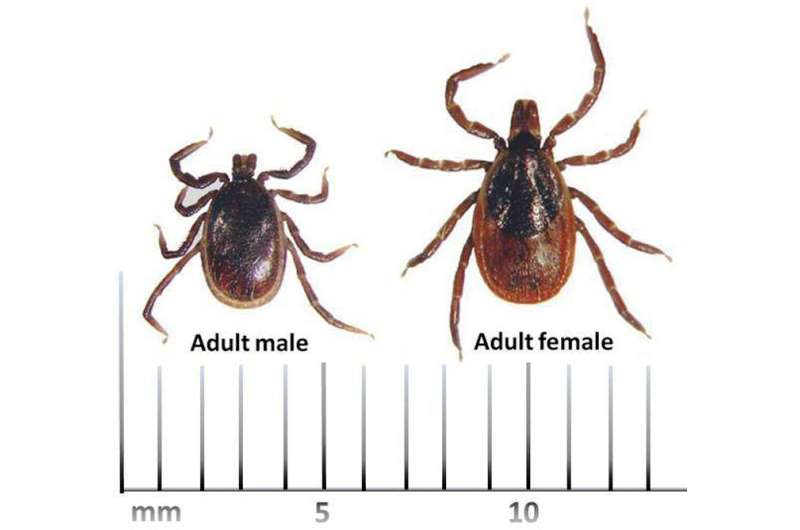Fewer reported Lyme disease cases may not tell whole story

Though Texas had almost 300 cases of Lyme disease reported in 2009, the number of reported cases since then has gone down considerably, leading experts to wonder if the disease is truly on the decline in the Lone Star State.
"Typically we see dozens of cases every year, mostly within the triangular region between Houston, Dallas and Austin," said Dr. Mike Merchant, Texas A&M AgriLife Extension Service urban entomologist based in Dallas. "Some of these cases occur in individuals who have been bitten by ticks outside the state, but many infections occur when people come in contact with a tick here in Texas."
In the past several years, reports to the Texas Department of State Health Services have gone from a high of 276 in 2009 to alow of 40 reported in 2014.
Merchant said while people typically don't hear much about Lyme disease in Texas, it's the most common insect-transmitted disease in the U.S. The greatest number of cases, over 20,000 a year, occur in the upper midwestern and northeastern states.
"Lyme disease is caused by the Borrelia burgdorferi bacterium and is carried by infected black-legged ticks," Merchant explained. "It can be a chronic debilitating disease of humans. Initial symptoms include fever, headache, fatigue and skin rash. Left undiagnosed and untreated, the disease can spread to the heart, joints and the nervous system."
The black-legged tick, Ixodes scapularis, is thought to be the principal vector of Lyme disease in Texas, he said.
"The adult is active during the fall and winter, and nymphs are active in spring and summer. Both nymphs and adults are capable of transmitting the bacterium to humans."
Merchant said while these statistics seem to bode well, Texas has the Lyme-disease carrying tick, and a few to dozens of people contract the disease from outdoor activity in Texas every year. He said said recent year's reported numbers likely underestimate the true instances of Lyme disease as it is less frequently tested in Texas than in parts of the country where it is better known and far more common.
"We also know that the ticks that carry Lyme disease are doing well enough to be showing up in more, rather than fewer, counties in Texas every year," he said. "The tick that carries Lyme disease is well established in Texas and its range appears to be expanding."
Wizzie Brown, AgriLife Extension entomologist for Travis County, is also hesitant to declare the disease is on the decline in Texas.
"The ticks that vector the disease are a fairly common species and it's fairly easy for humans to contract the disease," she said. "Most likely the statistical decline is in large part due to people not being tested for it or possibly being misdiagnosed because it's less common in Texas than other states."
Merchant added that doctors are concerned about the rising number of cases in some parts of the country, and that a new study by Centers for Disease Control researchers has shown a geographical expansion of the area where Lyme disease occurs.
"Researchers have now found black-legged ticks in 49 percent of all U.S. counties spread across 43 states," he said. "This represents an increase of almost 45 percent from 1998, when tick distribution was last mapped."
He added that the CDC report suggests that the tick's range is expanding in Texas. The tick status in the report has been upgraded in nine Texas counties to "reported" or "established," with established denoting six or more ticks or two or more life stages collected in a year.
"According to the study, the tick has now been found in 71 of the 254 Texas counties," he said.
Additional details on ticks, their identification, biology, geography, control and other factors can be found using the TickApp, http://tickapp.tamu.edu/, which was developed by Texas A&M AgriLife and the Southern IPM Center.
Merchant said even though reports of the Lyme disease in Texas are fewer, the need to be aware of ticks and the possibility of bringing home a tick or infection from the outdoors remains a distinct possibility, meaning precautions still need to be taken.
"We should all use tick repellent and inspect ourselves and our companions for ticks when venturing outdoors," he said. "Permethrin-containing sprays applied to clothing are the most effective repellents for ticks, though skin-applied repellents can also help.
He also noted that individuals should take time to learn the proper method of removing a tick, which is grasping close to the head with tweezers or protected fingers and pulling straight out.
"The sooner a tick is removed the less chance for disease transmission, he said. "The CDC advises to avoid folklore remedies such as 'painting' the tick with nail polish or petroleum jelly, or using heat to make the tick detach from the skin.
"The goal is to remove the tick as quickly as possible and not waiting for it to detach. Plus, heat and suffocants, like grease, may actually stimulate the tick to salivate, increasing your potential for infection."
He said although chances of infection with a tick-borne disease in Texas are relatively low, those experiencing a rash, fever, headache, joint or muscle pains or swollen lymph nodes within 30 days after possibly being bitten by a tick should tell their doctor.
"Knowing that a tick might have been involved will provide the information needed to properly diagnose the problem," Merchant said.
















